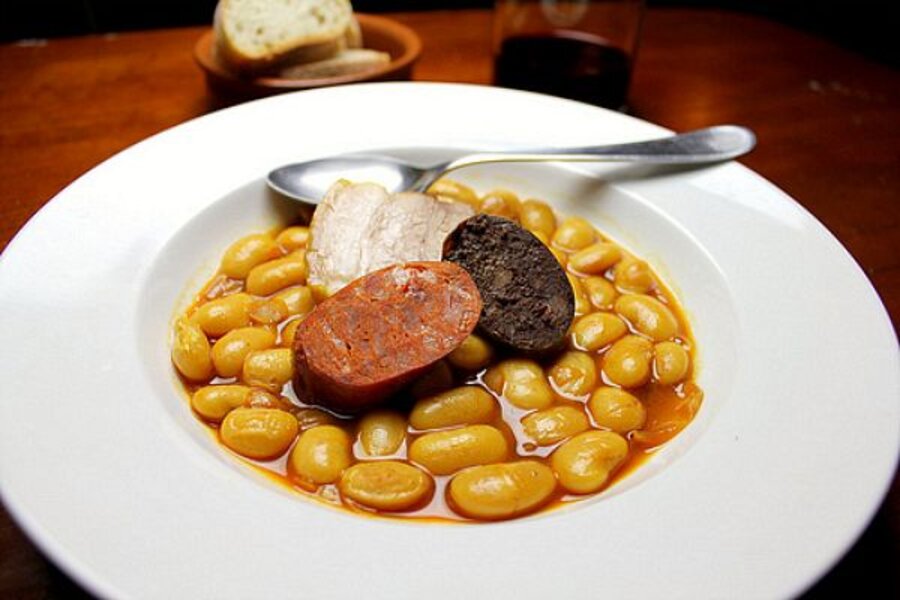Fabada Asturiana: A bean and sausage stew that may have altered history's course
Loading...
Almost seven years ago I journeyed in Spain from Santillana del Mar to Santa Maria de Lebaña by way of San Vicente de la Barquera. So many saints, so much devotion, that it was little surprise to learn that beyond the monastery of Santo Toribio de Liébana and the Picos de Europe mountain range lies the hallowed ground of Covadonga. It was here that the Christians held off the Moors to establish a foothold in the northern territories.
It was at the battle of Covadonga in 718 that Christian Spain under Pelayo, King of Asturias, began the reclamation of Iberia from the Muslim Moors. Nestled deep within the Asturian mountains, Covadonga is as important to the Spanish national myth as Hastings is to the British or Lexington to Americans. However, history defies such over-simplification – the linear narrative of one thing followed by another – and it is too easy to say that simply because certain events turned out the way they did there were no other possibilities. Indeed, a sentence stating that the defeat of a Moorish army by a Spanish king at Covadonga began the reconquest of Spain – which culminated in Ferdinand and Isabella vanquishing Boabdil, Emir of Granada, in 1492 – encompasses more than 700 years and glosses over seven whole centuries of war, shifting borders, switching alliances, inter-marriage, suffering, and grief.
It is with this in mind that I wonder if it’s an exaggeration to suggest that had the battle at Covadonga ended differently the whole course of Western history, and therefore of the world, would have been affected. Spanish historian Claudio Sanchez-Albornoz does not believe so. “Si los musulmanos no hubiesen conquistado el España en el siglo VIII, los españoles no habrian conquistado America en el XVI." (Translation: If the Muslims had not conquered Spain in the 8th century, the Americas wouldn’t have been conquered by the Spaniards in the 16th.) For him it follows that what began there in the 8th century resulted in a militarized and battle-hardened Spain conquering much of the New World.
For me, and my own personal sense of history those seven years ago, a dinner of beans, pork belly, chorizo and morcilla suggested just as plausible a theorem: that had not the Asturian armies under Pelayo feasted on fabada in preparation for the fight the next day, there may have been another outcome. And while personal experience suggests that after a hearty meal of this kind one is utterly disinclined to remaining awake, let alone to feeling lively enough to bum rush a horde of scimitar-brandishing Berbers, I still feel that this notion has validity.
After all, how could one’s sense of local patriotism and desire to defend one’s homeland fail to be stirred by such a dish? That the culinary use of saffron arrived in the far north of Spain via these same Moorish invaders and the integral ingredient smoked pimentón wasn’t to be discovered for another eight centuries following the conquest of Mexico doesn’t disprove this hypothesis, rather it merely serves to highlight, once again, the non-linear path of history.
Fabada (Asturiana bean and sausage stew)
Serves 2-4
1/2 lb. dried large white beans
1 head garlic, outer paper removed but still whole
1 large onion, peeled but whole
1 Spanish chorizo
1 morcilla (blood sausage)
1/2 lb pork belly or slab bacon
1 teaspoon smoked Spanish paprika
1 pinch Spanish saffron
1 quart low sodium chicken stock
Soak beans overnight or for at least 12 hours in abundant cold water.
Put drained rehydrated beans in a large pot with the chicken stock, pork belly, chorizo and morcilla. Bring to a boil and skim any white scum that rises to the surface. Add garlic, onion, pimenton and saffron and reduce heat to a simmer. Simmer gently for 2 hours adding more water if beans begin to dry out.
After two hours, remove meats and reserve, and remove onion and garlic and discard. Kill heat, replace lid and allow to stew for one hour.
Bring stew back to a boil and reduce liquid (if necessary) so that stew thickens but isn’t gloopy. Slice meats into serving portions and allow to reheat in hot stew before serving.
Jonny and Amy Seponara-Sills blog at We Are Never Full.
To comment on the original post, click here.
--------------------------------------------------------------
The Christian Science Monitor has assembled a diverse group of food bloggers. Our guest bloggers are not employed or directed by The Monitor and the views expressed are the bloggers' own and they are responsible for the content of their blogs and their recipes. All readers are free to make ingredient substitutions to satisfy their dietary preferences, including not using wine (or substituting cooking wine) when a recipe calls for it. To contact us about a blogger, click here.





